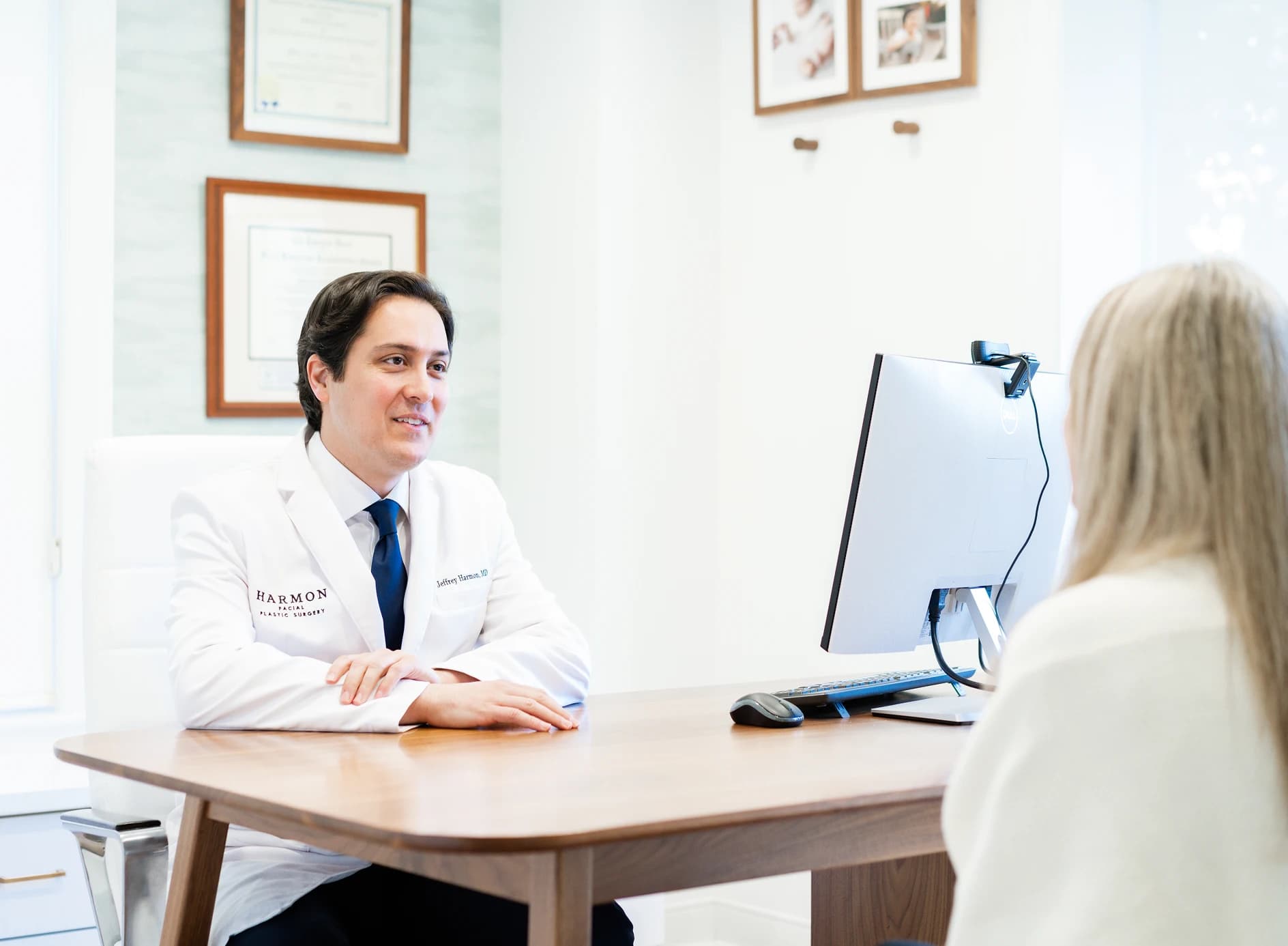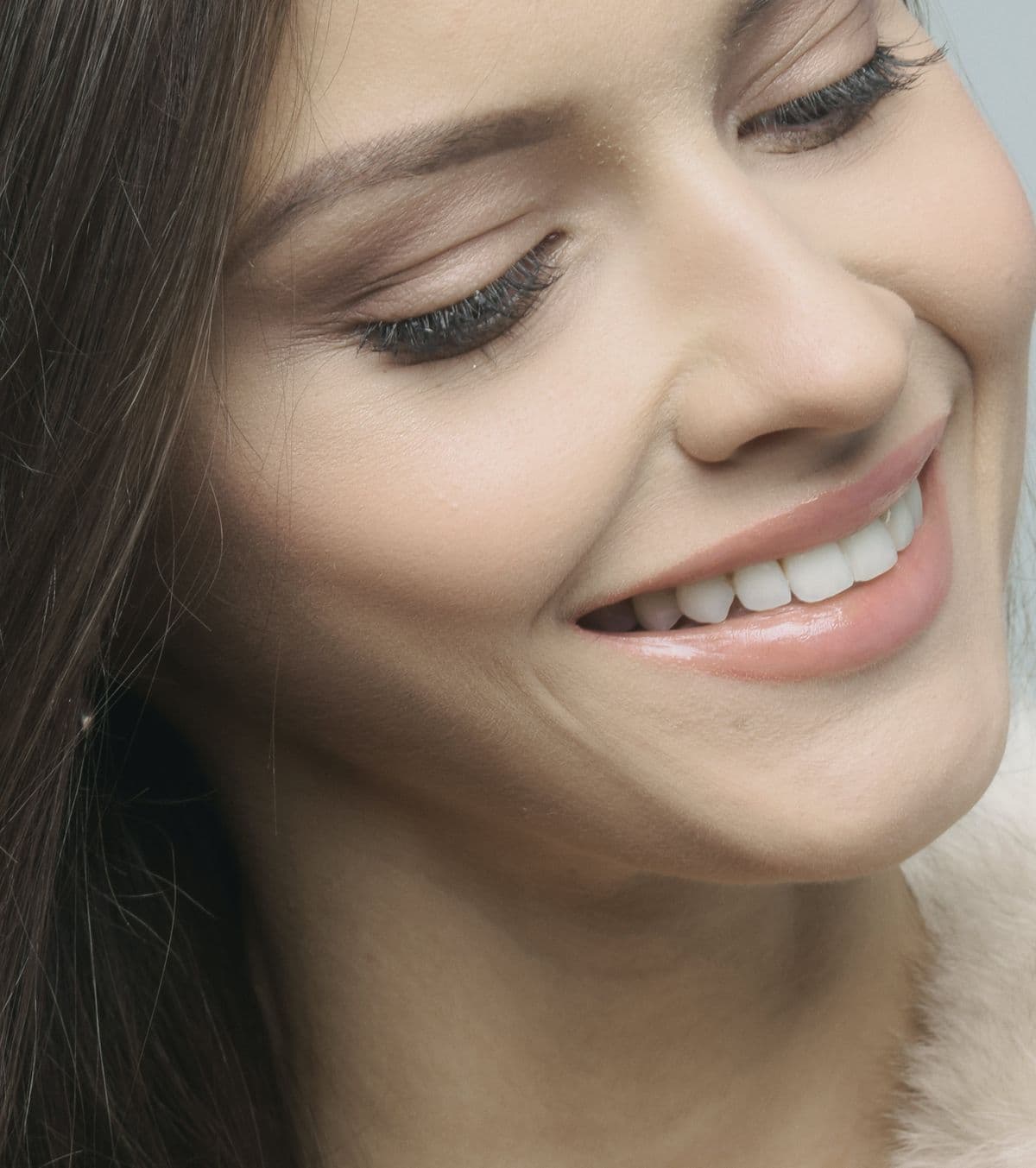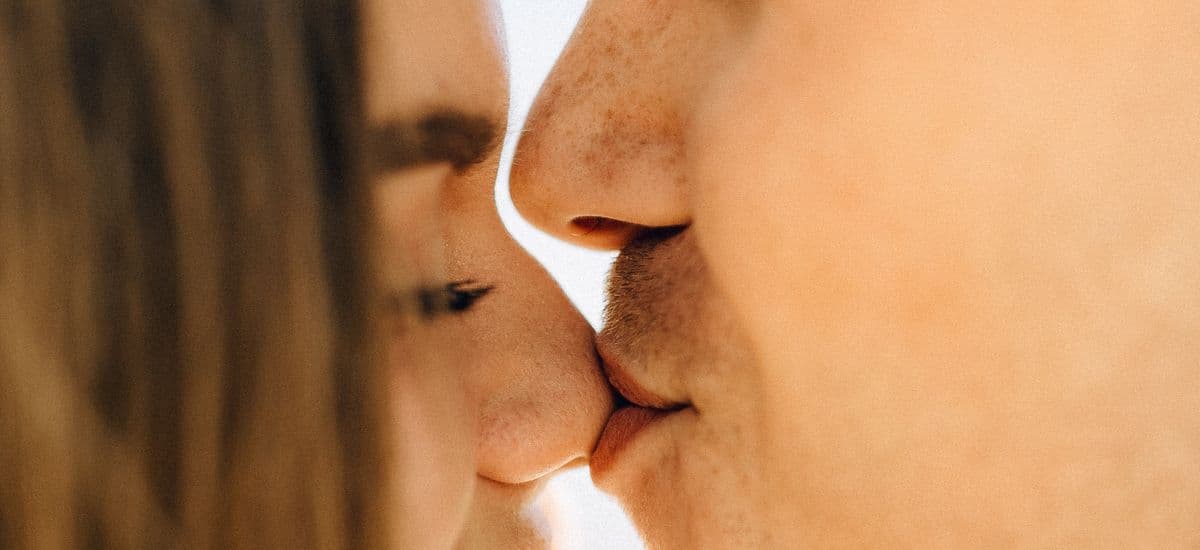Rhinoplasty
(Nose Surgery)- Dr. Harmon performs both an open rhinoplasty as well as a closed rhinoplasty, which involves incisions hidden entirely inside the nose
- Rhinoplasty can involve the entire nose or be more narrowly focused on the nasal bridge or the nasal tip
- Rhinoplasty can help address aesthetic and/or functional concerns about the nose
Contact Us
What is Rhinoplasty?
Rhinoplasty is a surgical procedure in which changes are made to the shape of the nose to achieve an aesthetic goal and/or improve breathing through the nose. The nose is composed of a complex of cartilage, bone, muscle, and connective tissue under the skin. It serves an important role balancing the aesthetics of the surrounding facial features. Its shape also affects air flow through the nose. The approach to rhinoplasty surgery depends on whether the goal is to improve the aesthetics of the nose, the function of the nose, or both. Incisions may be made at the base of the nose and inside the nasal cavities, depending on the surgical approach. These incisions allow access to visualize and manipulate the tissue deep to the skin.
What Conditions Does the Procedure Address?
Rhinoplasty surgery helps address aesthetic concerns about the nose and difficulty breathing through the nose. Conditions that a rhinoplasty can help address include:
Before & After
Explore our galleries to see the stunning, natural results Dr. Harmon delivers.
Why Choose Dr. Harmon
The desire for youthfulness is understandable. There is no area more important than the face. After all, the face cannot be hidden. It is how we present ourselves to the world. Dr. Harmon works with a refined eye and trained hands to develop a personalized treatment plan with you, utilizing advanced techniques in surgical and non-surgical care of the face, nose, eyes, neck and hair.
Fellowship trained facial plastic surgeons have a unique specialized skill set in performing surgical and non-surgical procedures on the face, nose, eyes, neck and hair. The pathway to becoming a facial plastic surgeon begins with five years of rigorous training in head and neck surgery. This training is focused on all aspects of surgery for the head and neck, in addition to aesthetic and reconstructive procedures.
A small pool of top performing graduates from head and neck surgery programs are then selected to complete sub-specialty training as a fellow in facial plastic and reconstructive surgery through the American Academy of Facial Plastic and Reconstructive Surgery (AAFPRS).
Dr. Harmon completed his fellowship in facial plastic surgery through the AAFPRS with the world-renowned facial plastic surgeon Dr. Andrew Jacono on Park Avenue in New York City. Dr. Jacono is world renowned for developing the extended deep plane facelift technique. Dr. Harmon is one of the few surgeons in the world, and the only surgeon in the Cincinnati area, fellowship trained in this technique by Dr. Jacono.
Quad A Accredited Surgery Suite
Harmon Facial Plastic Surgery is proud to have a Quad A accredited operating room and facility in our office. Our single-physician, single-specialty facility meets or exceeds the strict guidelines and high standards set forth by Quad A, demonstrating our strong commitment to patient safety and excellence in surgical care. We utilize the services of board-certified anesthesiology physicians only as well as our own personal clinical support staff to ensure the most comfortable, safest experience for our clients.
Types of Rhinoplasty Procedures
There are two surgical approaches to rhinoplasty surgery, open rhinoplasty and closed rhinoplasty. The differences between the approaches are primarily due to the different incisions used. The aesthetic and functional goals of rhinoplasty are the same, regardless of the type of rhinoplasty procedure.
Open Rhinoplasty
The most frequently performed rhinoplasty procedure is called an open rhinoplasty. An open rhinoplasty involves an incision across the base of the nose in the center of the columella. This incision is connected to additional incisions inside the nostrils, which are hidden from view. An open rhinoplasty allows direct visualization of the nasal anatomy under the skin in its natural position. As a result, more severe conditions can be addressed with more precise control over the anatomy.
Closed Rhinoplasty
A closed rhinoplasty involves incisions located entirely within the nostrils. This can not only accelerate the healing process but also demonstrates fewer external signs of surgery. Aesthetic concerns about the nasal bridge and nasal tip can be addressed using the closed approach to rhinoplasty. However, this approach may not be appropriate for more severe conditions or if more precise control over the shape of the nasal tip is necessary.
Overview of the Procedure
The team at Harmon Facial Plastic Surgery works tirelessly to prepare patients well for their procedure. The time spent with patients and resources provided facilitates a smooth transition from the procedure through recovery. The following overview is a broad summary of the information provided to patients:
Procedure Consultation
Expect a detailed, informative discussion with Dr. Harmon about your concerns and aesthetic goals. He will develop a personalized treatment plan to address these concerns and goals.
Pre-Treatment Preparation
Patients receive a packet with detailed pre-operative instructions prior to surgery. This packet includes information on what supplements and medications to hold prior to surgery, activity restrictions, and what supplies are necessary for post-operative recovery. Prescriptions are sent prior to surgery with instructions on their use. Finally, if medical clearance is required, a form detailing the necessary clearance and testing is provided to present to their primary care provider.
Day of Treatment
Patients are instructed to arrive at the office in comfortable clothes. The surgical plan is discussed with the patient in detail. Paperwork is completed. Photos are usually taken pre-operatively. Finally, the patient meets the surgical team, which may include nurses, anesthesiologists, and/or scrub technologists, depending on the procedure(s) and type of anesthesia used.
Follow-Up Appointment
Patients typically follow up for suture removal approximately five (5) days after surgery. If a splint is placed over the bridge of the nose, this is usually removed approximately seven (7) days after surgery. The timing of subsequent follow up appointments depends on how healing progresses.
Social Readiness
Swelling and bruises are expected after surgery. The time to resolution of swelling and bruises varies and depends on multiple patient-specific factors. Bruises tend to be significantly improved by seven (7) to ten (10) days after surgery. Swelling tends to improve significantly within approximately ten (10) to fourteen (14) days after surgery. Swelling is expected to resolve over the ensuing days and weeks. Most of the incisions are hidden inside the nasal cavities. If an open rhinoplasty is performed, an incision is placed at the base of the nose in an area called the columella. This incision is small and is usually inconspicuous. The incisions are expected to heal over a period of months. However, many feel ready to socialize approximately seven (7) to fourteen (14) days after surgery after swelling and bruises have improved.
Ideal Candidates for Rhinoplasty
Ideal candidates for rhinoplasty include those patients who demonstrate:
- A large, bulbous nasal tip
- A drooping nasal tip
- A hanging columella
- A hump on the bridge of the nose
- A wide nasal bridge
- Wide nostrils
- Flaring nostrils
- Significant asymmetries in the appearance of the nose
- Difficulty breathing through the nose
Candidates usually range in age from their twenties (20s) to their seventies (70s). A consultation is essential to determine candidacy for the procedure, because there may be factors that preclude this procedure for certain individuals. Reasonable expectations must be established about what a rhinoplasty can and cannot. Results can vary, as with all facial plastic surgery procedures.
What to Expect from Recovery
Recovery from a rhinoplasty is specific to the individual. The duration of recovery will vary from person to person.
The initial recovery time for this procedure for most patients is approximately seven (7) to fourteen (14) days. Sutures are usually removed approximately five (5) days after surgery. If a splint was applied to the bridge of the nose, this is usually removed approximately seven (7) days after surgery.
Swelling and bruises are expected after surgery. The time to resolution of swelling and bruises varies and depends on multiple patient-specific factors. Bruises tend to be significantly improved by seven (7) to ten (10) days after surgery. Swelling tends to improve significantly within approximately ten (10) to fourteen (14) days after surgery. Swelling is expected to resolve over the ensuing days and weeks.
Most of the incisions are hidden inside the nasal cavities. If an open rhinoplasty is performed, an incision is placed at the base of the nose in an area called the columella. This incision is small and is usually inconspicuous. The incisions are expected to heal over a period of months.
Sutures are removed
Splint is removed
Bruises are improved
Initial recovery
Swelling is improved
Benefits of Rhinoplasty
Rhinoplasty can help address both aesthetic concerns and functional problems associated with nasal breathing. The potential benefits of rhinoplasty surgery include:
- A straighter nasal bridge
- A more refined nasal tip
- A lifted nasal tip
- Improved breathing through the nose
Risks of Rhinoplasty
The potential risks of rhinoplasty include, but are not limited to:
- Bruising
- Swelling
- Infection
- Abnormal scarring
- Asymmetry
- Contour abnormalities
- Damage to the eyes
- Difficulty breathing through the nose
Combine Rhinoplasty with Other Facial Enhancements
Rhinoplasty surgery complements other surgical and non-surgical procedures well. Procedures that complement a rhinoplasty include, but are not limited to:
Deep Plane Facelift
Combining rhinoplasty with a deep plane facelift may enhance facial balance by refining the lower and midface, allowing the newly shaped nose to harmonize beautifully with rejuvenated contours.
Neck Lift
A neck lift helps sharpen the jawline and removes excess skin, and may further enhance the proportional impact of rhinoplasty for a more refined overall profile.
Brow Lift
Elevating the brow can open the upper face and create a more lifted, alert expression that may align naturally with changes in nasal structure and symmetry.
Blepharoplasty
Eye rejuvenation through blepharoplasty draws attention upward, and balancing nasal refinements may enhance the overall impression of facial freshness and symmetry.
Laser Skin Resurfacing
Resurfacing treatments can refine skin tone and texture around the nose and cheeks, helping to unify the appearance and may enhance the impact of nasal reshaping.
Fillers
Strategic filler placement after rhinoplasty can fine-tune facial contours or help balance subtle asymmetries, elevating the overall aesthetic outcome.
Botox©
Botox© soften expression lines and dynamic wrinkles, and may add subtle smoothness to areas around the eyes and forehead to complement nasal refinement.

Book Your Consultation
Take the first step toward your aesthetic goals with a personalized consultation. Dr. Harmon will listen to your concerns, answer your questions, and guide you through your options. Schedule your consultation today and discover how expert care can make a difference.
Read More About Rhinoplasty

What Concerns Can Be Addressed with Nose Surgery?
Nose surgery (rhinoplasty) can address multiple concerns about the nasal bridge (dorsum) and nasal tip. It is important to seek not only a...

What is the Difference Between a Functional and a Cosmetic Rhinoplasty?
The difference(s) between a functional and a cosmetic rhinoplasty is(are) of philosophy and goals, not necessarily of specific surgical maneuvers. A...
Is There Such a Thing as a “Scarless” Rhinoplasty?
The term "scarless" rhinoplasty is widely marketed. In reality, all incisions heal in a manner different than untouched skin. Incisions can be...
FAQ
What type of anesthesia is required?
Most patient require general anesthesia for rhinoplasty.
Is rhinoplasty covered by insurance?
Rhinoplasty is generally only covered by insurance if the procedure being performed is for the purposes of treating nasal obstruction leading to difficulty breathing through the nose. Any changes to the appearance of the nose for cosmetic reasons is not covered by insurance.
Can rhinoplasty treat obstructive sleep apnea (OSA)?
Rhinoplasty can open the nasal cavities up and improving breathing through the nose. This can sometimes improve tolerance of a CPAP device, the gold standard treatment for OSA. However, rhinoplasty cannot alone treat OSA.
Do rhinoplasty and septoplasty refer to the same procedure?
A septoplasty involves the removal and/or straightening of a portion of the nasal septum, a wall separating each nasal cavity and supporting the nasal tip bridge. A septoplasty is intended to treat nasal obstruction leading to difficulty breathing through the nose. A rhinoplasty involves surgery on the external cartilage and bone of the nose. A septoplasty is often performed with a rhinoplasty, both functional and cosmetic.
Does the skin on the nose change after rhinoplasty?
No. The skin does not change after rhinoplasty. However, it is normal to developed clogged pores after the nasal cast and tape are removed that is temporary and usually resolves within a few days.
Is the healing process longer for a revision (secondary) rhinoplasty?
Yes. The scar tissue from the previous rhinoplasty not only makes a revision more technically challenging but also prolongs the recovery. Patients tend to be swollen for longer and can heal at a less predictable rate and in a less predictable manner.
Can cosmetic and functional rhinoplasty be performed simultaneously?
Yes, a cosmetic and functional rhinoplasty can be performed at the same time. The surgical approach to rhinoplasty does not change whether surgery is performed to improve the appearance of the nose or to improve nasal breathing. As a result, improvements in the appearance and function of the nose can be made simultaneously. In fact, this is a very common approach to rhinoplasty.
Is rhinoplasty painful?
Facial plastic surgery procedures are generally well-tolerated by patients and typically involve little pain, especially when compared with surgery on other areas of the body. Patients are usually prescribed just a small amount of pain medication for after surgery. In fact, we have found most use only over-the-counter pain medication including acetaminophen and/or ibuprofen after surgery instead. And those who do use the prescribed pain medication usually only use it the first night after surgery. With that in mind, it is important to note that every patient perceives and processes pain differently. Some patients have a high pain tolerance. Others may be more predisposed to be more sensitive to pain. We at Harmon Facial Plastic Surgery are focused on balancing minimizing post-operative discomfort and maximizing safety.
Are there many visible incisions with a rhinoplasty?
No. There are two approaches to rhinoplasty that Dr. Harmon employs. The first and most commonly performed technique by most facial plastic surgeons utilizes a small, 3–4 mm incision at the center of the base of the nose with the remaining incisions inside the nose. This open rhinoplasty technique may be ideal for individuals who have had a rhinoplasty previously. It may also be ideal for an individual who desires extensive changes to their nose. The second technique is called a closed, or endonasal, rhinoplasty. This may be more appropriate for an individual who desires less extensive changes. All of the incisions are located inside the nose and are, therefore, hidden. There is typically much less swelling and bruising with this approach. Healing is faster overall. Dr. Harmon is one of the few surgeons in the country trained in this technique.
How long will it take before I see the final result of my rhinoplasty?
While the average recovery time from rhinoplasty is 7–10 days, the nose continues to heal and refine over a period of approximately 12 months.
Can rhinoplasty make the nostrils smaller?
Yes. Rhinoplasty can make wide nostrils smaller through a technique called alar reduction. This results in small external incisions at the margin where the nostrils meet the face.
How many rhinoplasties can I undergo?
Some individuals present to Dr. Harmon having undergone rhinoplasty elsewhere. Whether an additional procedure can be offered depends on multiple factors, including, but not limited to, the number of previous rhinoplasty surgeries, the extent of the previous surgeries, and the patient's past medical history. Every individual is unique. As a result, there is no single answer. However, it is important to understand that, the more rhinoplasties you undergo, the less predictable healing becomes.
How does rhinoplasty relate to a chin implant?
A recessed, or weak, chin can make the nose appear more projected than it actually is. A chin implant can be an excellent complement to rhinoplasty by reducing this perception after surgery.
Can rhinoplasty give me a celebrity's nose?
Every individual possesses their own unique nasal anatomy. As a result, a rhinoplasty cannot make a patient's nose look exactly like another's nose. However, surgery can achieve broad goals such as reducing the size of a nasal bump or narrowing the tip of the nose, thereby approximating aesthetically desirable features common to many celebrities and other individuals.
Is rhinoplasty a common surgical procedure?
Yes, rhinoplasty is a common surgical procedure. The International Society of Aesthetic Plastic Surgery (ISAPS) releases statistics each year that provide insight into the state of plastic surgery around the world. ISAPS reported 55,436 rhinoplasty procedures were performed in the United States in 2020.
Written by Dr. Harmon
Discover the expertise and compassionate care of Dr. Jeff Harmon, a fellowship-trained facial plastic surgeon deeply rooted in the Cincinnati community. A former collegiate athlete and Cornell University graduate, Dr. Harmon brings discipline, precision, and a global perspective to his surgical practice—refined through elite fellowship training in New York City.
Located in Hyde Park, Harmon Facial Plastic Surgery proudly serves patients throughout the Cincinnati area offering personalized facial aesthetics with world-class skill and a hometown heart.